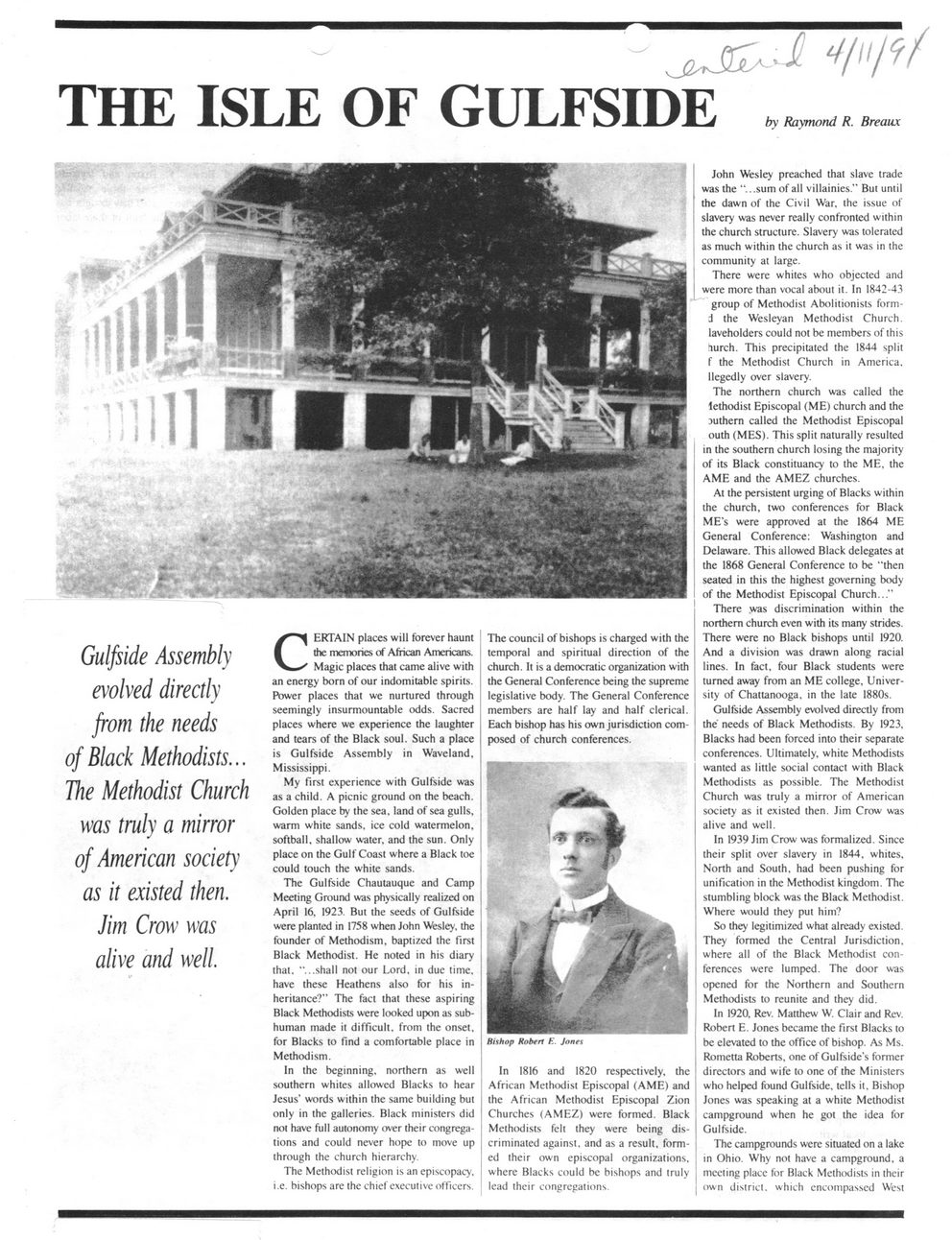This text was obtained via automated optical character recognition.
It has not been edited and may therefore contain several errors.
THE ISLE OF GULFSIDE by Raymond R. Breaux Gulfside Assembly evolved directly from the needs of Black Methodists... The Methodist Church was truly a mirror of American society as it existed then. Jim Crow was alive and well. CERTAIN places will forever haunt the memories of African Americans. Magic places that came alive with an energy born of our indomitable spirits. Power places that we nurtured through seemingly insurmountable odds. Sacred places where we experience the laughter and tears of the Black soul. Such a place is Gulfside Assembly in Waveland, Mississippi. My first experience with Gulfside was as a child. A picnic ground on the beach. Golden place by the sea, land of sea gulls, warm white sands, ice cold watermelon, softball, shallow water, and the sun. Only place on the Gulf Coast where a Black toe could touch the white sands. The Gulfside Chautauque and Camp Meeting Ground was physically realized on April 16, 1923. But the seeds of Gulfside were planted in 1758 when John Wesley, the founder of Methodism, baptized the first Black Methodist. He noted in his diary that, “...shall not our Lord, in due time, have these Heathens also for his inheritance?” The fact that these aspiring Black Methodists were looked upon as subhuman made it difficult, from the onset, for Blacks to find a comfortable place in Methodism. In the beginning, northern as well southern whites allowed Blacks to hear Jesus' words within the same building but only in the galleries. Black ministers did not have full autonomy over their congregations and could never hope to move up through the church hierarchy. The Methodist religion is an episcopacy, i.e. bishops are the chief executive officers. The council of bishops is charged with the temporal and spiritual direction of the church. It is a democratic organization with the General Conference being the supreme legislative body. The General Conference members are half lay and half clerical. Each bishop has his own jurisdiction composed of church conferences. sr f Bishop Robert E. Jones In 1816 and 1820 respectively, the African Methodist Episcopal (AME) and the African Methodist Episcopal Zion Churches (AMEZ) were formed. Black Methodists felt they were being discriminated against, and as a result, formed their own episcopal organizations, where Blacks could be bishops and truly lead their congregations. John Wesley preached that slave trade was the . .sum of all villainies.’* But until the dawn of the Civil War, the issue of slavery was never really confronted within the church structure. Slavery was tolerated as much within the church as it was in the community at large. There were whites who objected and were more than vocal about it. In 1842-43 group of Methodist Abolitionists form-i the Wesleyan Methodist Church, laveholders could not be members of this lurch. This precipitated the 1844 split f the Methodist Church in America, llegedly over slavery. The northern church was called the lethodist Episcopal (ME) church and the juthem called the Methodist Episcopal outh (MES). This split naturally resulted in the southern church losing the majority of its Black constituancy to the ME, the AME and the AMEZ churches. At the persistent urging of Blacks within the church, two conferences for Black ME’s were approved at the 1864 ME General Conference: Washington and Delaware. This allowed Black delegates at the 1868 General Conference to be "then seated in this the highest governing body of the Methodist Episcopal Church. . .” There was discrimination within the northern church even with its many strides. There were no Black bishops until 1920. And a division was drawn along racial lines. In fact, four Black students were turned away from an ME college, University of Chattanooga, in the late 1880s. Gulfside Assembly evolved directly from the needs of Black Methodists. By 1923, Blacks had been forced into their separate conferences. Ultimately, white Methodists wanted as little social contact with Black Methodists as possible. The Methodist Church was truly a mirror of American society as it existed then. Jim Crow was alive and well. In 1939 Jim Crow was formalized. Since their split over slavery in 1844, whites. North and South, had been pushing for unification in the Methodist kingdom. The stumbling block was the Black Methodist. Where would they put him? So they legitimized what already existed. They formed the Central Jurisdiction, where all of the Black Methodist conferences were lumped. The door was opened for the Northern and Southern Methodists to reunite and they did. In 1920, Rev. Matthew W. Clair and Rev. Robert E. Jones became the first Blacks to be elevated to the office of bishop. As Ms. Rometta Roberts, one of Gulfside’s former directors and wife to one of the Ministers who helped found Gulfside, tells it. Bishop Jones was speaking at a white Methodist campground when he got the idea for Gulfside. The campgrounds were situated on a lake in Ohio. Why not have a campground, a meeting placc for Black Methodists in their own district, which encompassed West

Gulfside Methodist Assembly The-Isle-of-Gulfside-(1)